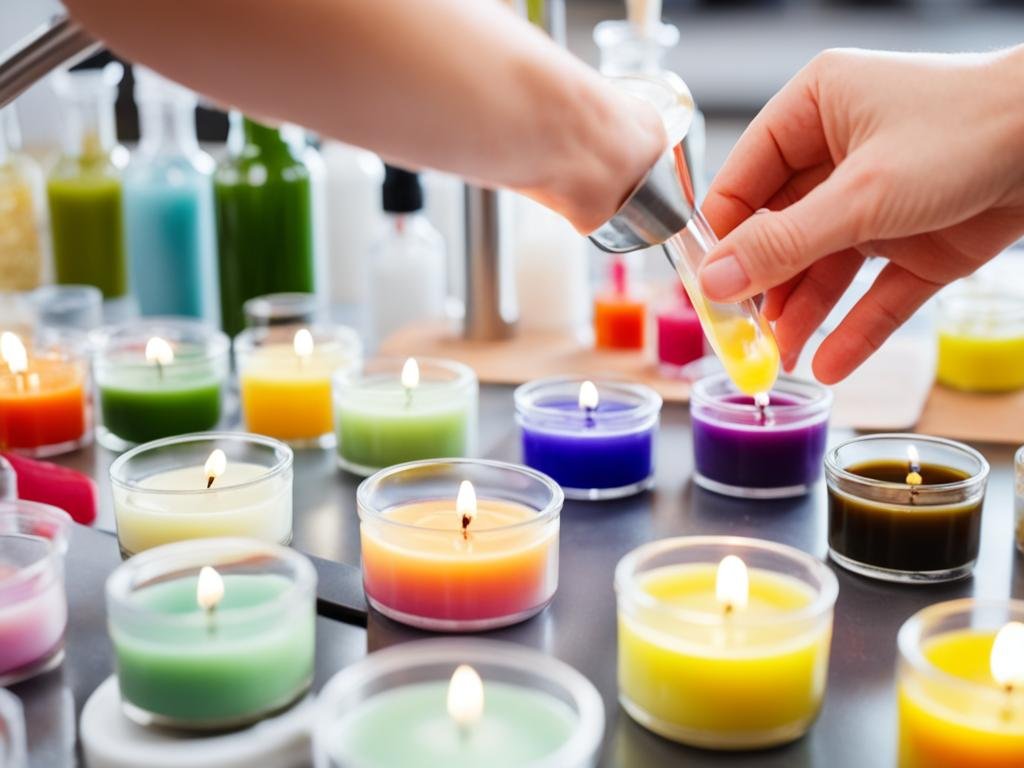
Welcome to Devil n Dove, where curiosity meets craft. We invite you to dive into the world of jewelry making and crafts, where every project is a chance to learn, grow, and create something beautiful. From the initial sketch to the final piece, we embark on an adventure together, exploring the art of molding wax models and bringing them to life.
At Devil n Dove, we believe that every creation tells a story. With each wax model, we pour our passion and creativity into crafting something unique and meaningful. Join us on this creative journey and discover the joy of bringing your ideas to life through jewelry making and crafts.
To start this exciting endeavor, it is essential to understand the process of preparing wax models for molding. From wax model preparation to the intricacies of the molding process, we will guide you every step of the way. With our expertise and your curiosity, you can unlock the potential of wax modeling and explore its endless possibilities.
Subscribe to Devil n Dove and hit the notification bell to stay connected and never miss out on our inspiring content. Join our community of like-minded individuals who are passionate about jewelry making and crafts. Prepare to be inspired, motivated, and challenged as we embark on this creative adventure together.
Welcome to Devil n Dove, where every creation tells a story.
Key Takeaways:
- Join Devil n Dove on a creative journey in jewelry making and crafts.
- Discover the art of molding wax models and bringing them to life.
- From first sketch to final piece, be part of our adventure.
- Subscribe and hit notifications for a world of inspiration.
- Every creation at Devil n Dove tells a unique story.
Steps for Preparing the Wax Model
Preparing a wax model for casting requires following a series of essential steps. To ensure a successful outcome, we recommend the following wax model molding techniques.
- First, create a plaster mixture by combining two parts plaster powder with one part water. This step is crucial as it forms the base for the mold. Gradually add the plaster powder to the water, stirring continuously to minimize the presence of air bubbles. Aim for a smooth consistency resembling pancake batter.
- Gently and slowly insert your wax sculpture into the plaster mixture. Take care to position the sprues in a way that they remain visible on the top surface. This technique is important as it allows for the creation of channels through which the molten metal or glass can be poured into the mold.
- Allow the plaster to set completely. This process usually takes several hours, so exercise patience while ensuring the mold is undisturbed.
- Once the mold has hardened, remove it from the container. Take caution to avoid any damage to the delicate wax model during this step.
- Bake the mold in a conventional oven to dry it out and pre-heat it. This step is essential before melting the wax out, as excessive moisture can cause issues during the casting process.
By following these wax model molding steps, you can ensure that your wax model is adequately prepared for casting, resulting in precise and accurate reproductions. Take a look at the image below to visualize the process:
“Preparing your wax model with care and attention to detail is essential for achieving remarkable results in the lost wax casting process. Take your time and follow these steps diligently for a successful outcome.”
Wax Model Molding Tips:
- Consider using specialized wax carving tools to achieve intricate details in your sculpture.
- Ensure that your plaster mixture is smooth and free from lumps, as these can affect the quality of the mold.
- Be mindful of the positioning of the sprues, as they play a crucial role in allowing the molten material to flow into the mold.
- Regularly check the hardness of the mold before removing it from the container, as premature handling can result in damage to the wax model.
- Use a reliable oven thermometer to ensure that the mold is thoroughly dried and pre-heated before proceeding with the casting process.
By implementing these wax model molding techniques and following the necessary steps, you can create high-quality molds that are ready for casting. Remember, proper preparation is key to achieving excellent results in your casting endeavors.
Benefits of Using the Lost Wax Casting Process
The lost wax casting process offers numerous benefits for molding wax models. Notably, it enables the capture of intricate details in both metal and glass, making it a highly versatile technique. This ancient process has been used for thousands of years and continues to be valued in contemporary manufacturing and fine art. The precision and accuracy inherent in lost wax casting make it ideal for creating objects with thin walls, intricate details, and precise tolerances.
One of the key advantages of lost wax casting is its ability to produce parts for various industries, including transportation, agriculture, and medicine. With the right techniques and tips, this process can yield excellent results in creating molds for wax models.
“Lost wax casting allows for the creation of highly detailed and accurate metal or glass objects.”
Benefits of Lost Wax Casting:
- Ability to capture fine details
- Versatility for both metal and glass
- Historical significance and ongoing use
- Precision and accuracy for intricate designs
- Ideal for objects with thin walls and close tolerances
- Applicable to various industries
Through a combination of skill, craftsmanship, and attention to detail, lost wax casting unlocks the potential to create stunning replicas and unique pieces. The process’s enduring appeal lies in its ability to transform wax models into masterpieces that capture the imagination.
| Benefits of Lost Wax Casting | Potential Applications |
|---|---|
| Highly detailed and accurate objects | Fine art, jewelry, and sculpture |
| Versatility in working with metal and glass | Automotive and aerospace industries |
| Precision for objects with thin walls | Medical device and dental industries |
Working with Modelling Wax
Modelling wax is a soft material that can be easily shaped by hand. It is commonly used for sculpting prototypes, which can then be converted into permanent copies through the lost wax casting process. Modelling waxes have the advantage of being sensitive to temperature, allowing them to firm up when cooled and providing a firm support for continued modeling. They can also be softened using heat or heated tools to modify the surface. Modelling waxes maintain their consistency well and can be intermixed to vary their properties. However, modelling waxes cannot be made hard and permanent on their own, and they are not suitable for sticking to other materials without assistance.
To illustrate the versatility of modelling wax, here are some key points to consider:
- Easy Shaping: Modelling wax’s softness allows for effortless shaping, making it a preferred material for artists and sculptors.
- Temperature Sensitivity: Modelling wax reacts to temperature changes, becoming firm when cooled and offering stability during the modeling process.
- Surface Modification: Heat can be applied to soften modelling wax or alter its surface using heated tools, enabling artists to achieve desired details and textures.
- Consistency and Property Variation: Modelling waxes maintain a consistent composition and can be mixed to create customized textures and properties for specific projects.
- Dependence on the Lost Wax Casting Process: While modelling wax is a versatile material, it requires the lost wax casting process to transform prototypes into permanent copies.
Working with modelling wax offers artists and sculptors the freedom to bring their creative visions to life. Its flexibility allows for experimentation and precise detailing, resulting in stunning final products. Whether you’re an experienced artist or a beginner, modelling wax can be an invaluable tool for artistic expression.
Support us at www.devilndove.com or our store at www.devilndove.online to learn more about preparing wax models for molding.
Conclusion
Preparing the wax model for molding is an essential step in the lost wax casting process. By following the steps outlined in this guide, you can ensure that your wax model is properly prepared for casting. Modelling wax offers a flexible and versatile material for creating prototypes, and the lost wax casting process allows for the creation of highly detailed and accurate metal or glass objects.
With a combination of techniques and tips, you can achieve excellent results in molding wax models for various applications. Whether you are creating jewelry, sculptures, or industrial components, proper preparation of the wax model is crucial for obtaining the desired outcome. Taking the time to carefully mold and prepare the wax model will result in a final product that reflects the intricate details and craftsmanship of your design.
For more information on preparing wax models for molding and to explore our wide range of products, visit our website at www.devilndove.com or shop online at www.devilndove.online. We are dedicated to providing resources and support to help you enhance your wax modeling skills and achieve exceptional casting results.
FAQ
How do I prepare a wax model for molding?
To prepare a wax model for molding, you need to create a plaster mixture, gently insert the wax sculpture into the plaster, allow the plaster to set, and then bake the mold in an oven to dry it out and pre-heat it before melting the wax out.
What are the steps for preparing a wax model?
The steps for preparing a wax model include creating a plaster mixture, gradually inserting the wax sculpture into the plaster, allowing the plaster to set, and baking the mold in an oven to dry it out and pre-heat it before removing the wax.
What are the benefits of using the lost wax casting process?
The lost wax casting process allows for capturing fine details in both metal and glass, making it highly versatile. It is ideal for creating objects with thin walls, intricate details, and close tolerances. The process has been used for thousands of years and is still widely used in manufacturing and fine art today.
How does working with modelling wax benefit the wax model molding process?
Modelling wax is a soft material that can be easily shaped and makes an ideal choice for sculpting prototypes. It can be cooled to firm up, providing a solid support for continued modeling. Modelling waxes have consistent consistency and can be heated to modify the surface. However, they cannot be made hard and permanent on their own and require assistance to stick to other materials.
Where can I find more information about preparing wax models for molding?
You can find more information about preparing wax models for molding by visiting our website at www.devilndove.com or our online store at www.devilndove.online. We offer additional resources and guides to help you with the wax model molding process.
Source Links
RELATED POSTS
View all



